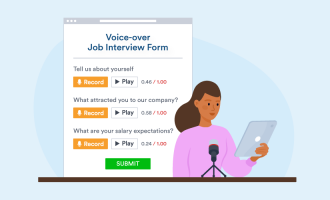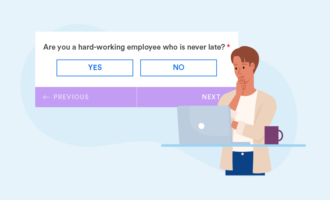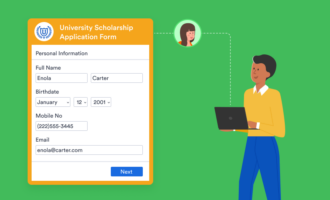5 Essential qualitative data collection methods
- One-on-one interviews
- Open-ended surveys and questionnaires
- Focus groups
- Observation
- Case studies
Data collection is an important tool for understanding the behavior and motivations of your audience. It helps you gather intel on the kinds of products, services, and initiatives they’d like to see. Good data also makes it easier for you to identify ways to improve the experience they have with your organization at every touchpoint.
There are two main kinds of data collection — qualitative data collection and quantitative data collection. We’re going to focus on qualitative data-collection methods here.
Pro Tip
Learn how to gather data the right way – check out free tips on data collection from Jotform.
What’s the difference between qualitative and quantitative data?
Quantitative data is numerical data that can be ranked, categorized, and measured — like the number of customers who spent over $50 last year, the gross or net profit for a specific time period, or the number of subscribers who converted into buyers from an email marketing campaign.
This kind of data answers closed-ended questions, such as “how many” or “how much,” and you can collect it through surveys, polls, and questionnaires.
Qualitative data is descriptive rather than numerical, and it looks for context — it’s about people’s perceptions. You gather it to understand the reasons and motivations that drive certain behavior. For example, qualitative data can reveal people’s feelings and opinions about your organization, and you can use it to determine why customers buy your products (or don’t).
Quantitative data can tell you about your market share, the demographics of your customers, and how often they buy your products or use your services. Basically, qualitative data can give you the story behind the story. One way to gather this data is through open-ended surveys and questionnaires, but let’s look at a few more.
Qualitative data-collection methods
One-on-one interviews
Face-to-face interviews are one of the most common qualitative data-collection methods; they’re a great approach when you need to gather highly personalized information.
Informal, conversational interviews are ideal for asking open-ended questions, which allow you to gain rich, detailed context and gather in-depth insights into participants’ opinions, experiences, and behavior. And because the interview format provides an opportunity to ask follow-up questions, you’ll be able to fill in any information gaps and gather additional insights.
You can also apply a mixed method by gathering information beforehand using one of Jotform’s interview forms.
Open-ended surveys and questionnaires
Open-ended surveys and questionnaires allow participants to answer freely at length, rather than choosing from a set number of responses, so you get more nuanced and detailed answers. For example, you might ask an open-ended question like “Why don’t you eat ABC brand pizza?”
You would then provide space for people to answer narratively with their opinion or perspective, rather than simply giving them a specific selection of responses to choose from like “I’m a vegan,” “It’s too expensive,” or “I don’t like pizza.”
And because surveys and questionnaires can be executed online, they’re easier to distribute, allow for wider reach, and give you the ability to collect more qualitative data, more easily.
You can easily create a survey using Jotform’s free online survey maker. Simply add your questions, set up conditional logic, and share your custom survey online to start collecting responses instantly.
Focus groups
Focus groups are similar to interviews, except that you conduct them in a group format. You might use a focus group when one-on-one interviews are too difficult or time-consuming to schedule. A focus group will typically consist of eight to 10 people.
Focus group participants are chosen based on the topic the researcher wants to gather insights about. For example, a focus group might be formed to provide feedback on a new marketing campaign from a number of demographically similar people in your target market or to allow people to share their views on a new product.
Qualitative data collected through focus groups can be highly detailed and descriptive, providing the ideal opportunity to gather nuanced information in a short period of time.
Observation
Observation is a traditional qualitative data-collection method in which researchers observe subjects in the course of their regular routines, take detailed field notes, and/or record subjects via video or audio. This method is useful when you want to gain a more refined understanding of participants in their natural environment.
The two main types of observation are covert and overt.
As the name suggests, covert observation is when researchers are concealed, and participants don’t know they’re being observed. For example, researchers may embed themselves in public places like stores or restaurants, or in online chat rooms, in order to gather data in a natural setting.
Overt observation is when participants are aware they’re being studied. This method allows researchers to ask questions and record conversations.
Use Jotform’s free, customizable online observation form to get started.
Case studies
In the case study method, you analyze a combination of multiple qualitative data sources to draw inferences and come to conclusions.Case studies are typically structured to explore a problem, a solution, and the impact of the solution.
If you’re in the marketing space, you’ve likely seen case studies used to highlight the impact of a company’s service within a specific target market. For example, an advertising agency might use a case study to showcase how it helped a healthcare client improve the customer service experience across digital channels, or how it helped a technology client launch a campaign for a new laptop.
The case study would include the situation before and after the agency’s intervention, demonstrating the successful results of the agency’s work.
When should you use qualitative vs quantitative data-collection methods?
To get the best results, you need to rely on both quantitative and qualitative data-collection methods. You’ll get deeper insights when you use a combination of the two.
Qualitative research offers context and nuance, and it can help you develop a fuller understanding of the complexities of human behavior related to your organization’s products or services. It’s data wrapped in a rich contextual story.
That said, qualitative data research can take a lot of time to collect and analyze, and it can sometimes result in biased conclusions. That’s why you should pair it with quantitative data collection to get the best, most accurate information.
For businesses and organizations that want to improve their marketing and outreach game, these qualitative data research methods can help:
- Determine obstacles to purchasing your company’s products or using your company’s services.
- Gain insights into how clients and customers perceive your brand.
- Identify areas for improvement across the entire brand discovery and buying cycle.
- Pinpoint where your messaging may be muddled or confusing.
- Discover in-demand product features to implement.
- Understand how your brand compares to others in the market.
- Gauge marketing campaign performance.
- Identify how your website, apps, and other online assets are performing.
Jotform is a great resource for creating the kind of open-ended surveys and questionnaires that you need for qualitative data collection. And you can use Jotform for quantitative data collection as well. Whichever data-collection method you choose, Jotform can help with a wide range of surveys and questionnaires.

































Send Comment:
4 Comments:
More than a year ago
Clearly explained and strait to the point.Thank you
More than a year ago
simple and clear English, easy to understand. Thank you.
More than a year ago
I have learnt the difference between the qualitative and quantitative data and also tools of collecting such data. Simple clear language used. Thanks a lot.
More than a year ago
THANKS TO JOTFORM FOR SUCH A HIGHLY INFORMATIVE ARTICLE, I HAVE LEARNT ALOT FROM IT. I NOW HAVE ADEQUATE ANSWERS FOR ME TO TACKLE MY ASSIGNMENTS ON QUALITATIVE AND QUANTITAVE DATA.